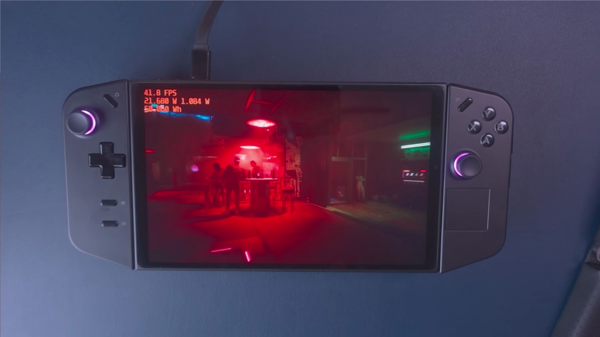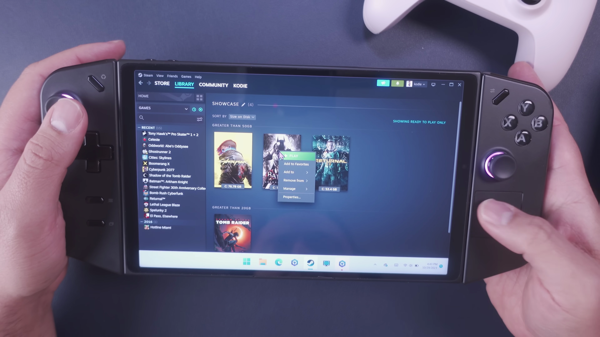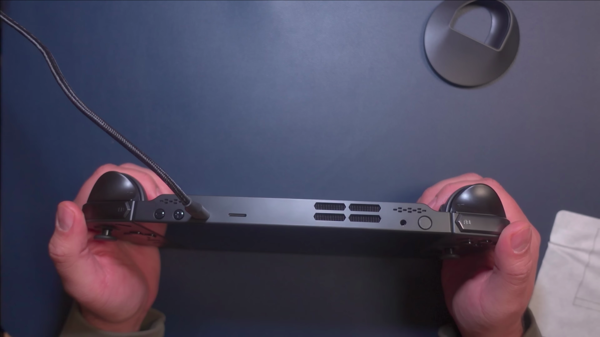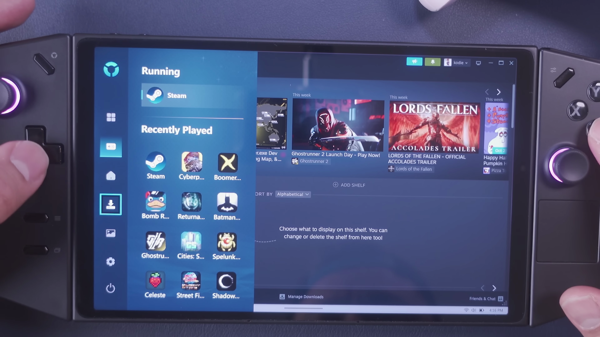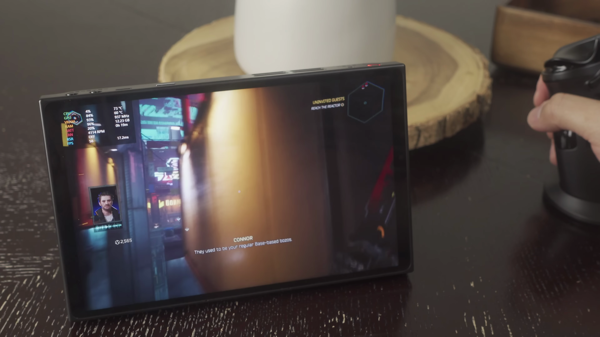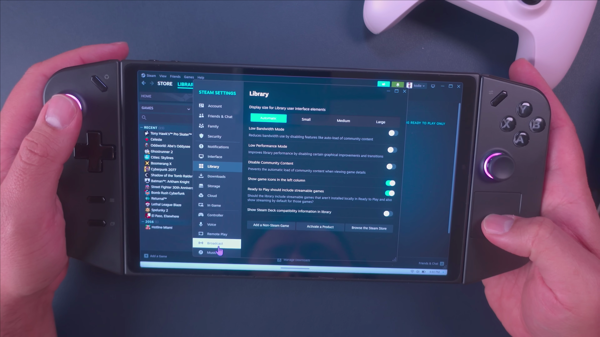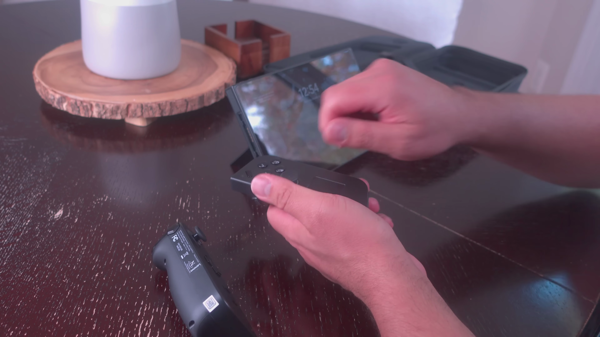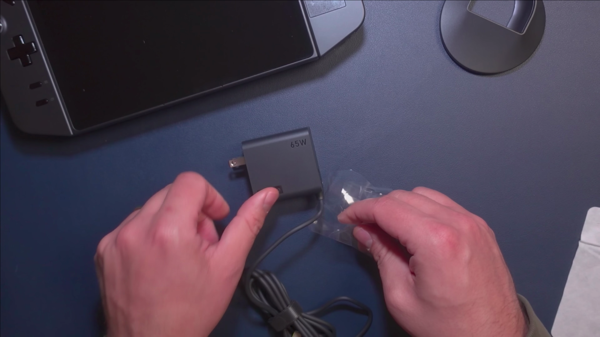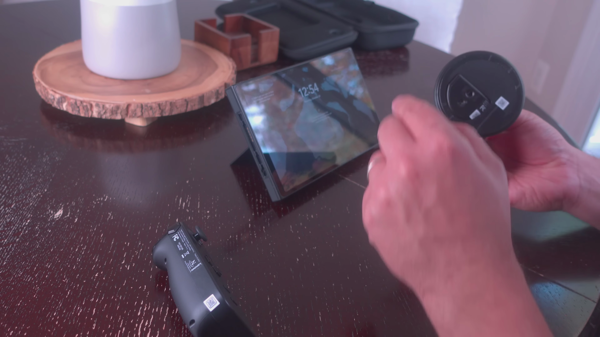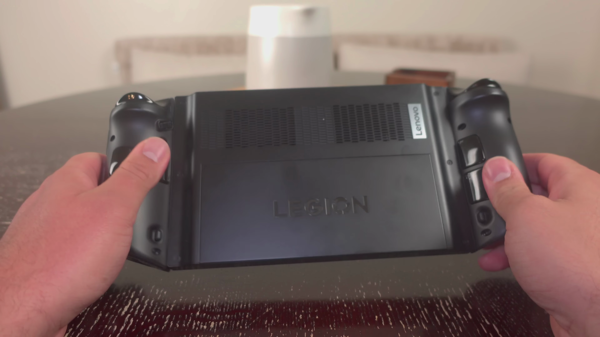Note: As an Amazon Associate I earn from qualifying purchases.
My Lenovo Legion Go gaming experience (2023): a long review
Introduction
I was skeptical yet also interested when I heard Lenovo was entering the handheld gaming world with the Legion Go. Coming from a background in gaming tech, I was curious about how their device would stack up. The prospect of detachable controllers and a large display was novel, but would it really work in such a compact form factor? Below is my hands-on experience with it - particularly compared to the Steam Deck.
Prices
Check prices of the Lenovo Legion Go on:
Photos
Click on photos to enlarge them:
Initial Impressions and Design

As an avid tech enthusiast and handheld gaming aficionado, I found myself both excited and apprehensive when Lenovo announced its foray into the handheld gaming market with the Lenovo Legion Go. Right out of the gate, the headline features—detachable controllers and an 8.8-inch display—signaled Lenovo’s intentions to shake things up. But first impressions count a lot with handhelds, as they aim to blend power with portability.
The sheer size and weight (1.88 pounds with controllers) set the Legion Go apart from its peers. It’s noticeably bulkier than the Steam Deck and Asus ROG Ally, and while this extra heft hints at a more packed feature list, it unavoidably dings its portability score. The unit’s mass is in service of its unique features, particularly its large screen, which boasts a 2560 x 1600 resolution. As stunning as higher resolutions can be, their practicality on a gaming handheld is debatable since many titles struggle to run optimally at such settings without a power source.
Design-wise, the Legion Go is undeniably built to capture attention. The detachable controllers, reminiscent of the Nintendo Switch, add a layer of versatility, although they can’t be used as separate controllers for multiplayer gaming. They do feel substantial and are generously button-equipped, an ergonomic challenge for some. But the tradeoff of having what is effectively a “gaming tablet” when the controllers are detached is an intriguing prospect.
However, there’s still no avoiding the Lenovo Legion Go’s transportability problem. Even with a provided case that feels more like a packing cube than protective wear, its dimensions don’t readily lend themselves to lightweight travel. Casual gamers, in particular, might find smaller devices like the Steam Deck more appealing for on-the-go use.
The Legion Go’s integrated kickstand is a well-thought-out addition, showcasing a design ethos committed to providing a quality gaming experience in various settings. It’s a detail that adds value, making it easier to use with the controllers detached or when one simply wants to enjoy media without holding the device.
For those into connectivity, the Legion Go steps up. Boasting two USB Type-C 4.0 ports, it comes out ahead for individuals who might want to use the device for more productivity tasks, like connecting to a monitor while charging. The inclusion of a 3.5 mm headphone jack and a microSD card slot further underline its commitment to functionality.
On the downside, some design choices feel a tad experimental, like the FPS mode utilizing a bottom sensor on the right controller for aiming in shooter games; an innovative idea that users might find clunky without a desk or table.
Within this personal assessment lies a conflict, a balance between admiration for innovation and practical considerations regarding usability. By trying to do everything, the Legion Go stretches across the spectrum of gaming needs and wants. It seems to prioritize features over finesse in some areas, such as the questionable necessity of a high-resolution screen that outpaces the handheld’s gaming performance capabilities.
From a hands-on perspective, the Legion Go is undeniably interesting. It’s commendable to see Lenovo so boldly entering this space with ideas that push the envelope. Yet I can’t help but wonder whether the focus was spread too thinly across too many features. Sure, many of the Legion Go’s elements stand out individually—like that massive screen—but for a handheld gaming PC, the purpose is inevitably tied to convenience and practicality, areas in which the device’s bulky design might deter the very market it seeks to capture.
Performance and Gaming Experience
As someone who’s spent a considerable amount of time gaming on various devices, I had certain expectations from the Lenovo Legion Go. It’s the kind of device that sits in the niche between traditional laptops and consoles, pushing towards new territory with its Switch-like detachable controllers and large screen.
Starting with the performance, the Legion Go sports an AMD Z1 Extreme APU, which is the same chip found in the Asus ROG Ally. The overall experience is comparable in terms of horsepower, but in plugged-in scenarios, the Go takes full advantage of the chip’s capacity. I set a custom TDP of 30 watts which is the max for this device, to see what it could really do. With the balanced profile running while unplugged, performance does take a hit, but that’s expected with high-performing handhelds.
In game tests, titles like Control and Rocket League showed that 1280 x 800 is the sweet spot for this screen; the large resolution of 2560 x 1600 is indeed overkill for intense gaming. However, one cannot deny the vividness and clarity it adds to less demanding games or while streaming video. The 144 Hz refresh rate is a dream in eSports titles, displaying the raw capability of the screen as it presents fast-paced action smoothly and without any perceived lag.
What troubled me a tad bit was the apparent weight and bulkiness. At 1.88 pounds with controllers, it’s a solid piece of kit to hold for protracted periods. The weight could be a drawback for some, considering portability and comfort during extended gaming sessions.
I’ve also noted some minor tradeoffs in usability. The device does get warm, but thanks to the detachable controllers, it doesn’t hinder the gaming experience as much as I feared. However, the fan does get loud under load, which, without noise-canceling headphones, could get a bit intrusive.
The Legion Go’s 256GB SSD is not the largest, but as someone who values upgradeability, knowing that the storage is easily swappable is a plus. This, coupled with the ample 16GB LPDDR5X RAM, means games and multitasking run smoothly.
Now, special mention goes to FPS mode. It’s unlike anything I’ve seen in handhelds before. Using a sensor and a magnetic disc, it effectively turns the right controller into a vertical mouse of a kind, a concept appealing for first-person shooters. The catch? It can feel clunky and less intuitive than simply connecting a mouse, so I’m a bit on the fence about its practicality.
Battery life is another trade-off - while playing Control on low settings, I noticed a battery drop to 28% after an hour and a half, which is something to keep in mind if you’re not near a power source.
There’s Lenovo’s own Legion Space software to consider as well, which attempts to streamline Windows 11 for a handheld gaming device. While it’s a good concept, it still needs more work to be as intuitive as Valve’s SteamOS interface on the Steam Deck.
In summary, the Lenovo Legion Go provides an impressive nod towards what the future of handheld gaming could be. With certain drawbacks in weight and some software quirks, it’s not without its challenges, but it pioneers features and performance that are hard to find elsewhere in the handheld market. For those who are looking for a premium screen and the novelty of detachable controllers, the Legion Go is an enthralling option. More information on its specs can be found on Lenovo’s official website.
Software Interface and Usability

After spending considerable time with the Lenovo Legion Go, its interface and usability warrant a thorough examination. As someone who frequently dives into the diverse ecosystem of handheld gaming PCs, I couldn’t help but harbor some preconceptions about Windows 11 operating on a gaming-oriented device. Let’s face it, Windows wasn’t exactly sculpted for the handheld experience, and it shows. The lack of a touch-friendly interface is evident—the joysticks aren’t reliable for mouse control, necessitating a reliance on the touchpad or, more practically, your fingers on the screen.
The Legion Space software, a utility designed to bridge the gap between Windows and a seamless handheld experience, is ambivalent in performance. On one hand, it offers a myriad of settings—from thermal modes to lighting effects—and in theory, could see you through without needing to dive into Windows. However, the software feels disjoint in places, needing perhaps more polish to reach its full potential. For instance, navigating to certain games or adjusting settings sometimes didn’t feel as smooth as it could be.
What stood out was the Quick Settings feature—a boon simplifying access to pivotal controls. Yet, there were sporadic instances where the menu refused to pop up during a game, nudging me out and into the full Legion Space utility for adjustments. These Minority Report-esque moments of clunkiness can interrupt the gaming flow, which, for handheld devices, should aim for the seamless.
There are sections within Legion Space that come off as underdeveloped or simply links to external sites. The “Android Game” and “Cloud Gaming” portions, in my experience, added little value to what should be a more integrated offering. These felt less like solutions and more of placeholders—an area Lenovo can hopefully address in subsequent updates. Despite this, the library and settings components were indispensable, particularly when adjusting the TDP or transitioning from the native 2560 x 1600 resolution down to a more gaming-friendly 1280 x 800.
The touch keyboard’s responsiveness, or lack thereof, is another point of contention. Its reluctance to spring forth when needed, especially in instances such as entering two-factor authentication codes, added unnecessary inconvenience. One would argue that an omnipresent keyboard when no physical one is connected should be a given on a gaming tablet.
The physical aspects of the Legion Go control setup bring their weight to bear on the overall usability. The detachable controllers, while a novel concept, lead to some unwieldiness. In theory, their separation should allow for versatility, yet in practice, they’re somewhat awkward to reattach and lack the intuitiveness one might expect. While the utility of a touchpad and additional programmable buttons is noted, some ergonomics were sacrificed in their inclusion, resulting in frequent accidental button presses.
All in all, the interface and usability of the Lenovo Legion Go resemble the proverbial jack-of-all-trades. There’s no denying that Lenovo has sought to pave its path with innovative solutions like FPS mode and detachable controllers. Yet, they still have some length to tread to refine the software and button layout for it to be a master of the handheld domain. Despite these gripes, Lenovo remains committed to updates that I remain hopeful will iron out the current nuisances, unleashing the full potential of this handheld PC. The way forward for the Legion Go is filled with promise—time and developer attention will tell how much of it turns into reality.
Comparison With Other Handhelds and Final Thoughts

After spending a considerable amount of time testing the Lenovo Legion Go, it’s time to slot it into the current landscape of handheld gaming PCs and offer some final thoughts. There’s no question that the Legion Go enters a crowded market, with the Steam Deck and Asus ROG Ally being its most direct competitors. Each device seems to cater to slightly different preferences and use cases, and that’s a healthy situation for consumers.
Let’s dive into the Legion Go itself. I appreciate the ambition Lenovo has shown here—the detachable controllers and the large, vibrant 8.8-inch screen are standout features. The additional USB Type-C ports offer a surprising and welcome level of connectivity for a handheld device. The AMD Z1 Extreme chip is certainly capable, giving the Legion Go a solid performance base, though the 2560 x 1600 screen resolution seems to overshoot what’s necessary or even practical for gaming on this device. I’ve found myself scaling down to 1280 x 800 for optimal gaming performance, echoing Lenovo’s own recommendations.
However, the bulkiness of the device cannot be ignored. It’s more substantial in weight and size compared to its competitors, which affects its portability. That might be a dealbreaker for some, especially those looking for a ‘grab-and-go’ gaming experience. Its battery performance, while decent, doesn’t facilitate extended unplugged sessions, a key component of a portable system.
In comparison, the Asus ROG Ally and Valve Steam Deck each have their merits. The Ally’s commitment to a 7.4-inch display may offer less screen real estate, but it results in better portability. The Steam Deck’s Linux-based SteamOS and custom APU are designed for an optimal handheld gaming experience, albeit at the cost of Windows compatibility. The Legion Go errs on the more powerful, feature-rich side but seems to stumble a bit on the practical aspects of being a handheld.
The Legion Space software deserves a mention as it aims to streamline the Windows experience for a handheld. Yet it falls short when compared to Steam’s Big Picture mode in terms of ease of use. It’s clear that Legion Go’s software needs refining to truly leverage the hardware’s potential.
When it comes to preference, users must weigh up which factors are most important: screen size, portability, performance, or software experience. An ideal device would excel in all categories, but compromises are a reality. The Legion Go favors screen size and feature set; however, those seeking the utmost in portability or a smoother software experience may find better options elsewhere.
The added competition in the handheld gaming market is undoubtedly positive, pushing manufacturers to innovate and cater to a broader audience. This competition benefits us, the users, offering us options that align closer with our individual needs.
In conclusion, the Lenovo Legion Go is a bold step forward, introducing features that set it apart from the competition. Despite its shortcomings, such as portability and software finesse, it stands as a powerful, feature-rich device that expands the possibilities of handheld gaming. As the race among manufacturers continues, it’s exciting to watch and participate in the evolution of this market segment, as new contenders like the Legion Go push boundaries and explore new designs. The ultimate winner in this competition is the consumer, who now has more options than ever.
